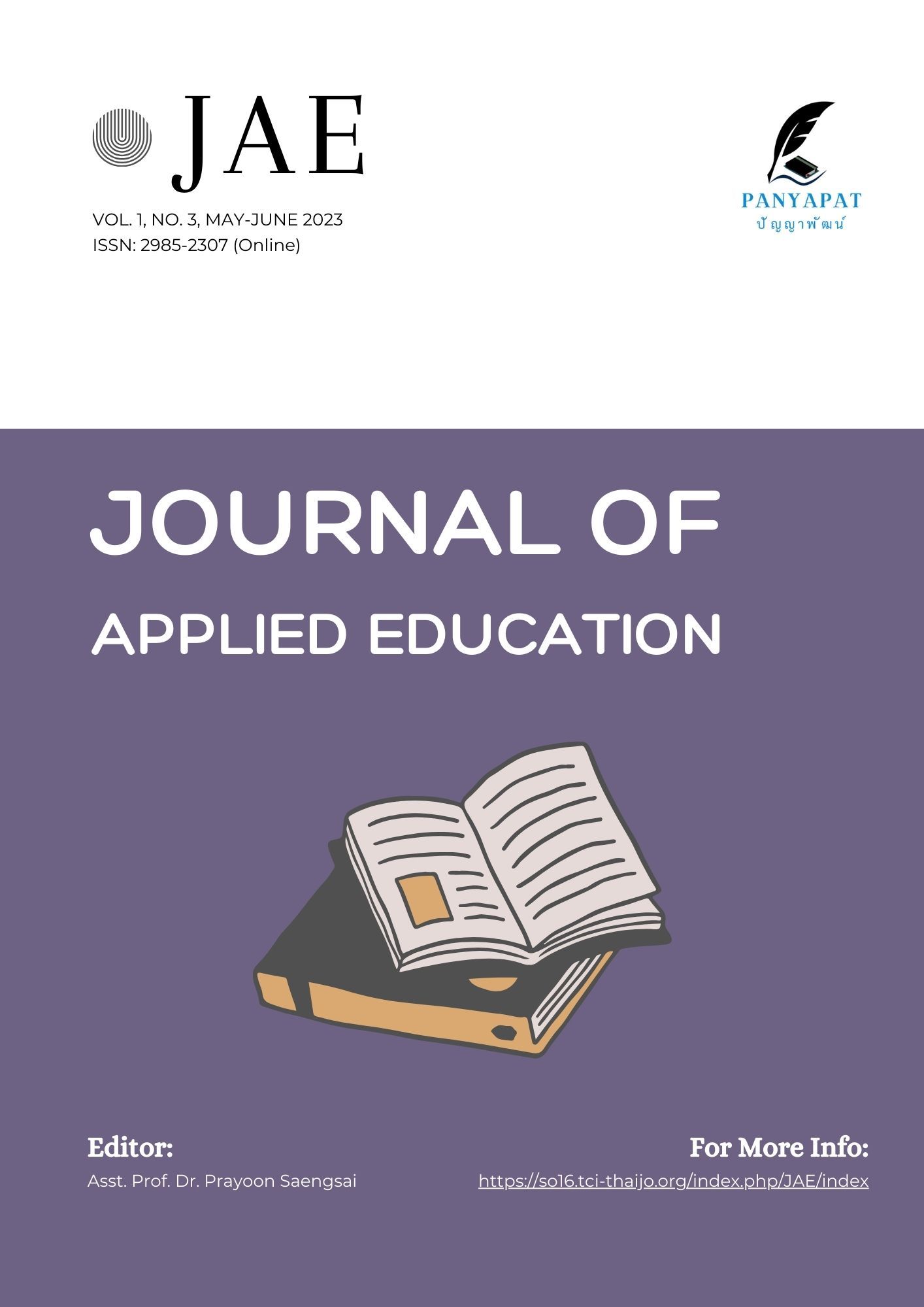Learning Thai in The 21st Century Using The Brain As a Base
Main Article Content
Abstract
This article aims to present about learning Thai in the 21st century using the brain as a base. The 21st century is a time of rapid change in information and communication technology. The new century focuses on teaching and learning management that is most relevant to today's society and helps to promote learning management and live their own lives to keep up with the changes Management of Thai language learning must define objectives and processes, content, which lead to learning management in the 21st century using the brain as a base. Teachers organize activities to suit the content and abilities of the learners, it will give the learners valuable instilling in language skills. fostering a good attitude towards learning Thai Including the opinion of the value of the Thai language as a tool to communicate ideas and understanding each other.
Article Details

This work is licensed under a Creative Commons Attribution-NonCommercial-NoDerivatives 4.0 International License.
References
กมลฉัตร กล่อมอิ่ม. (2560). การจัดการเรียนรู้โดยใช้สมองเป็นฐาน สำหรับนักศึกษาวิชาชีพครูสาขาพลศึกษา. Veridian E-Journal, Silpakorn University ฉบับภาษาไทย สาขามนุษยศาสตร์ สังคมศาสตร์ และศิลปะ, 10(1), 77-89.
กระทรวงศึกษาธิการ. (2552). หลักสูตรการศึกษาขั้นพื้นฐาน พุทธศักราช 2551. กรุงเทพฯ: คุรุสภาลาดพร้าว.
กาญจนา สุนันตา. (2555). การใช้กิจกรรมดาราทีบีเอ็มเพื่อพัฒนาทักษะภาษาไทยของนักเรียนชั้นมัธยมศึกษาปีที่ 2 โรงเรียนดาราวิทยาลัย จังหวัดเชียงใหม่. (ศึกษาศาสตรมหาบัณฑิต, มหาวิทยาลัยเชียงใหม่).
ธัญญรัตน์ อุยโต. (2561). การพัฒนาทักษะการเขียนกลุ่มสาระการเรียนรู้ภาษาไทยโดยการจัดการเรียนรู้แบบใช้สมองเป็นฐานของนักเรียนชั้นประถมศึกษาปีที่ 3. (การศึกษามหาบัณฑิต, มหาวิทยาลัยศรีนครินทรวิโรฒ).
พรพิไล เลิศวิชา และ อัครภูมิ จารุภากร. (2550). สมองวัยเริ่มเรียนรู้. กรุงเทพฯ: สถาบันวิทยาการเรียนรู้.
พรพิไล เลิศวิชา. (2550). สมองเรียนรู้อย่างไร. กรุงเทพฯ: ศาลาแดง.
รัตถภรณ์ คำกมล และ บุษบา บัวสมบูรณ์. (2559). การศึกษาผลสัมฤทธิ์ด้านการแต่งคำประพันธ์ประเภทกาพย์ยานี ของผู้เรียน ชั้นประถมศึกษาปีที่ 5 ที่ได้รับการจัดการเรียนรู้ตามแนวสมองเป็นฐาน. Veridian E-Journal, Silpakorn University ฉบับภาษาไทย สาขามนุษยศาสตร์ สังคมศาสตร์ และศิลปะ, 10(2), 1060-1077.
ลิขสิทธิ์ พุฒเขียว. (2554). การพัฒนาการจัดกิจกรรมการเรียนการสอนทางไกล เพื่อส่งเสริมการสืบสอบหาความรู้ด้วยตนเองของนักศึกษาทางไกล สถาบันการศึกษาทางไกล. (ครุศาสตรมหาบัณฑิต, จุฬาลงกรณ์มหาวิทยาลัย).
วิจารณ์ พานิช. (2555). วิถีสร้างการเรียนรู้เพื่อศิษย์ในศตวรรษที่ 21. กรุงเทพฯ: มูลนิธิสดศรี-. สฤษดิ์วงศ์.
วิมลรัตน์ สุนทรโรจน์. (2551). นวัตกรรมตามแนวคิดแบบ Back ward Desing. มหาสารคาม: ภาควิชาหลักสูตรและการสอน คณะศึกษาศาสตร์ มหาวิทยาลัยมหาสารคาม.
ศูนย์เรียนรู้ มหาวิทยาลัยรังสิต. (2566). การเรียนรู้โดยใช้สมองเป็นฐาน (Brain Based Learning) ตอนที่ 1. สืบค้น 5 มกราคม 2566. จาก https://lc.rsu.ac.th/weblog/11.
สถาบันคลังมองของชาติ. (2551). สมองกับการเรียนรู้. กรุงเทพฯ: เบสท์ กราฟฟิค เพรส.
สนิท สัตโยภาส. (2547). กระบวนการเรียนรู้ชูผู้เรียนเป็นสำคัญ. กรุงเทพฯ: คุรุสภา ลาดพร้าว.
สุจริต เพียรชอบ และ สายใจ อินทรัมพรรย์. (2538). วิธีสอนภาษาไทยระดัยมัธยมศึกษา. (พิมพ์ครั้งที่ 3). กรุงเทพฯ: โรงพิมพ์จุฬาลงกรณ์มหาวิทยาลัย.
Ananiadou, K., & Claro, M. (2009). 21st century skills and competences for new millennium learners in OECD countries. OECD education working papers, no. 41. United States: OECD Publishing (NJ1).
Call, N. (2003). The thinking child brain-based learning for the foundation stage. PO Box 635 Stafford: Network Educational Press Ltd.
CEDEFOP (Thessaloniki). (2008). The shift to learning outcomes: Conceptual, political and practical developments in Europe. Luxembourg: Office for official publications of the European Communities.
Dede, C. (2007). Transforming education for the 21st century: New pedagogies that help all students attain sophisticated learning outcomes. Commissioned by the NCSU Friday Institute. Retrieved 2 January 2023. from https://citeseerx.ist.psu.edu/document?repid=rep1&type=pdf&doi=bb7f5f9ebda4ebe662364f534e1bce027f655623.
Dede, C. (2010). Comparing frameworks for 21st century skills. In J. Bellance, & R. Brandt (Eds.), 21st century skills: Rethinking how students learn (pp. 51-76). Bloomington: Solution Tree Press.
Jensen, E. (2000). Moving with the brain in mind. Educational leadership, 58(3), 34-37.
Partnership for 21st Century Skills. (2009). P21 Framework Definitions. Retrieved 2 January 2023. from https://files.eric.ed.gov/fulltext/ED519462.pdf.
Politano, C., & Paquin, J. (2000). Brain-based learning with class. Winnipeg, Manitoba: Portage & Main Press.

